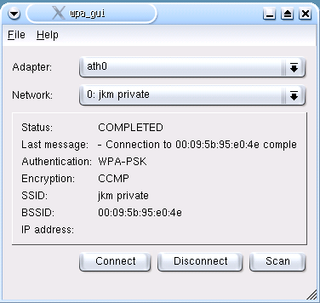
IEEE 802.11 is part of the IEEE 802 set of local area network (LAN) technical standards, and specifies the set of medium access control (MAC) and physical layer (PHY) protocols for implementing wireless local area network (WLAN) computer communication. The standard and amendments provide the basis for wireless network products using the Wi-Fi brand and are the world's most widely used wireless computer networking standards. IEEE 802.11 is used in most home and office networks to allow laptops, printers, smartphones, and other devices to communicate with each other and access the Internet without connecting wires. IEEE 802.11 is also a basis for vehicle-based communication networks with IEEE 802.11p.
In cryptography, RC4 is a stream cipher. While it is remarkable for its simplicity and speed in software, multiple vulnerabilities have been discovered in RC4, rendering it insecure. It is especially vulnerable when the beginning of the output keystream is not discarded, or when nonrandom or related keys are used. Particularly problematic uses of RC4 have led to very insecure protocols such as WEP.

Wi-Fi is a family of wireless network protocols based on the IEEE 802.11 family of standards, which are commonly used for local area networking of devices and Internet access, allowing nearby digital devices to exchange data by radio waves. These are the most widely used computer networks, used globally in home and small office networks to link devices and to provide Internet access with wireless routers and wireless access points in public places such as coffee shops, hotels, libraries, and airports to provide visitors.
A wireless gateway routes packets from a wireless LAN to another network, wired or wireless WAN. It may be implemented as software or hardware or a combination of both. Wireless gateways combine the functions of a wireless access point, a router, and often provide firewall functions as well. They provide network address translation (NAT) functionality, so multiple users can use the internet with a single public IP. It also acts like a dynamic host configuration protocol (DHCP) to assign IPs automatically to devices connected to the network.
Wired Equivalent Privacy (WEP) was a severely flawed security algorithm for 802.11 wireless networks. Introduced as part of the original IEEE 802.11 standard ratified in 1997, its intention was to provide data confidentiality comparable to that of a traditional wired network. WEP, recognizable by its key of 10 or 26 hexadecimal digits, was at one time widely used, and was often the first security choice presented to users by router configuration tools.
Wi-Fi Protected Access (WPA), Wi-Fi Protected Access 2 (WPA2), and Wi-Fi Protected Access 3 (WPA3) are the three security certification programs developed after 2000 by the Wi-Fi Alliance to secure wireless computer networks. The Alliance defined these in response to serious weaknesses researchers had found in the previous system, Wired Equivalent Privacy (WEP).
IEEE 802.11i-2004, or 802.11i for short, is an amendment to the original IEEE 802.11, implemented as Wi-Fi Protected Access II (WPA2). The draft standard was ratified on 24 June 2004. This standard specifies security mechanisms for wireless networks, replacing the short Authentication and privacy clause of the original standard with a detailed Security clause. In the process, the amendment deprecated broken Wired Equivalent Privacy (WEP), while it was later incorporated into the published IEEE 802.11-2007 standard.
Temporal Key Integrity Protocol is a security protocol used in the IEEE 802.11 wireless networking standard. TKIP was designed by the IEEE 802.11i task group and the Wi-Fi Alliance as an interim solution to replace WEP without requiring the replacement of legacy hardware. This was necessary because the breaking of WEP had left Wi-Fi networks without viable link-layer security, and a solution was required for already deployed hardware. However, TKIP itself is no longer considered secure, and was deprecated in the 2012 revision of the 802.11 standard.
Counter Mode Cipher Block Chaining Message Authentication Code Protocol or CCM mode Protocol (CCMP) is an encryption protocol designed for Wireless LAN products that implements the standards of the IEEE 802.11i amendment to the original IEEE 802.11 standard. CCMP is an enhanced data cryptographic encapsulation mechanism designed for data confidentiality and based upon the Counter Mode with CBC-MAC of the Advanced Encryption Standard (AES) standard. It was created to address the vulnerabilities presented by Wired Equivalent Privacy (WEP), a dated, insecure protocol.
A wireless distribution system (WDS) is a system enabling the wireless interconnection of access points in an IEEE 802.11 network. It allows a wireless network to be expanded using multiple access points without the traditional requirement for a wired backbone to link them. The notable advantage of WDS over other solutions is that it preserves the MAC addresses of client frames across links between access points.
IEEE 802.11r-2008 or fast BSS transition (FT), is an amendment to the IEEE 802.11 standard to permit continuous connectivity aboard wireless devices in motion, with fast and secure client transitions from one Basic Service Set to another performed in a nearly seamless manner. It was published on July 15, 2008. IEEE 802.11r-2008 was rolled up into 802.11-2012. The terms handoff and roaming are often used, although 802.11 transition is not a true handoff/roaming process in the cellular sense, where the process is coordinated by the base station and is generally uninterrupted.
In cryptography, a related-key attack is any form of cryptanalysis where the attacker can observe the operation of a cipher under several different keys whose values are initially unknown, but where some mathematical relationship connecting the keys is known to the attacker. For example, the attacker might know that the last 80 bits of the keys are always the same, even though they don't know, at first, what the bits are.
Extensible Authentication Protocol (EAP) is an authentication framework frequently used in network and internet connections. It is defined in RFC 3748, which made RFC 2284 obsolete, and is updated by RFC 5247. EAP is an authentication framework for providing the transport and usage of material and parameters generated by EAP methods. There are many methods defined by RFCs, and a number of vendor-specific methods and new proposals exist. EAP is not a wire protocol; instead it only defines the information from the interface and the formats. Each protocol that uses EAP defines a way to encapsulate by the user EAP messages within that protocol's messages.

Wireless security is the prevention of unauthorized access or damage to computers or data using wireless networks, which include Wi-Fi networks. The term may also refer to the protection of the wireless network itself from adversaries seeking to damage the confidentiality, integrity, or availability of the network. The most common type is Wi-Fi security, which includes Wired Equivalent Privacy (WEP) and Wi-Fi Protected Access (WPA). WEP is an old IEEE 802.11 standard from 1997. It is a notoriously weak security standard: the password it uses can often be cracked in a few minutes with a basic laptop computer and widely available software tools. WEP was superseded in 2003 by WPA, a quick alternative at the time to improve security over WEP. The current standard is WPA2; some hardware cannot support WPA2 without firmware upgrade or replacement. WPA2 uses an encryption device that encrypts the network with a 256-bit key; the longer key length improves security over WEP. Enterprises often enforce security using a certificate-based system to authenticate the connecting device, following the standard 802.11X.

wpa_supplicant is a free software implementation of an IEEE 802.11i supplicant for Linux, FreeBSD, NetBSD, QNX, AROS, Microsoft Windows, Solaris, OS/2 and Haiku. In addition to being a WPA3 and WPA2 supplicant, it also implements WPA and older wireless LAN security protocols.
In cryptography, a pre-shared key (PSK) is a shared secret which was previously shared between the two parties using some secure channel before it needs to be used.
IEEE 802.1AE is a network security standard that operates at the medium access control layer and defines connectionless data confidentiality and integrity for media access independent protocols. It is standardized by the IEEE 802.1 working group.
A Wi-Fi deauthentication attack is a type of denial-of-service attack that targets communication between a user and a Wi-Fi wireless access point.

KRACK is a replay attack on the Wi-Fi Protected Access protocol that secures Wi-Fi connections. It was discovered in 2016 by the Belgian researchers Mathy Vanhoef and Frank Piessens of the University of Leuven. Vanhoef's research group published details of the attack in October 2017. By repeatedly resetting the nonce transmitted in the third step of the WPA2 handshake, an attacker can gradually match encrypted packets seen before and learn the full keychain used to encrypt the traffic.
In cryptography, Simultaneous Authentication of Equals (SAE) is a password-based authentication and password-authenticated key agreement method.












